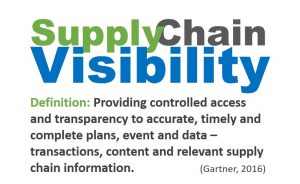Visibility Matte rs.
rs.
Rick Morris, a Certified Supply Chain Professional wrote in Supply House Times that while improving fill rates, improved forecast accuracy also lowers inventory levels measured in days of sales; and simultaneously, improved forecast accuracy improves fill rates and lowers inventory. He suggested this translates into increased profitability. When analysts have studied companies that were best-in-class in demand forecasting, they found these companies averaged (according to Advanced Market Research) 15% less inventory; 17% higher perfect order fulfillment; 35% shorter cash-to-cash cycle times; and 1/10 the stock outs of their peers. In addition, every 3% increase in forecast accuracy increased profit margin by 2%. These improvements in inventory efficiencies then translate into improved financial metrics, including 10% improvement in earnings per share; 5% increase in return on assets; and a 2.5% gain in profits.
Reducing the Risk of Supply Chain Disruptions
Sunil Chopra and ManMohan S. Sodhi, reported for the MIT Sloan Management Review, that supply chain executives complain there have been major supply chain disruptions, highlighting vulnerabilities for individual companies and for entire industries globally. Today’s managers know that they need to protect their supply chains from serious and costly disruptions, but the most obvious solutions — increasing inventory, adding capacity at different locations and having multiple suppliers — undermine efforts to improve supply chain cost efficiency. Surveys have shown that while managers appreciate the impact of supply chain disruptions, they have done very little to prevent such incidents or mitigate their impacts. This is because solutions to reduce risk mean little unless they are weighed against supply chain cost efficiency. After all, financial performance is what pays the bills.
Supply Chain Market reported the closest any manufacturer can get to the magic bullet is supply chain visibility. Supply chain visibility is needed to achieve a manufacturers’ goal of saving money quickly and inexpensively. Supply chain visibility means all partners get access to data in real-time. Visibility to all orders allows suppliers to proactively respond to abnormal fluctuations in demand. Poor visibility often results in parts shortages. Frustrated manufacturers report having no idea they were down to the last box of parts. The result is expensive, requiring faster shipping methods to get the part back on the shop floor. A real-time view of parts on hand allows a supply chain manager to take-action before there is a stock out, eliminating expedited fees.
eKanban software provides an effective quick win. An eKanban system can mitigate disruptions associated with stock outs through automated inventory replenishment and visibility into real-time demand signals, supplier response and more. Current manufacturing Kanban technologies have evolved to automate and simplify even the most complex supply chains.
In addition to eKanban, many of today’s manufacturers are taking advantage of all the digitization created to enable the Internet of Things and elevating visibility within and beyond their four walls – and across multi-enterprise environments. So, what steps are manufacturers taking toward this end, and more importantly, what is the investment?
The answer depends upon your starting point.
In a recent research report, Gartner defines their five stages of maturity in supply chain visibility to include: Asset; functional; supply chain; value chain; and ecosystem visibility. (Gartner, Define the Five Stages of Supply Chain Visibility Maturity, 2016.) As an organization moves toward greater maturity, the number of disparate data sources to be aggregated and made visible multiplies. As such, web-based and SaaS priced visual factory information systems (VFIS) are gaining favor based on their flexible technology architecture, affordability and ability to easily scale – manufacturers can use the same system to visualize information as they mature through the stages. And because the VFIS connects to any data source (legacy systems, ERP, MES, PLM, WMS, machines, etc.), manufacturers wouldn’t necessarily need to invest in any other systems to get started on impacting the bottom line through greater supply chain visibility.
We will spend more time exploring how manufacturers are creating greater supply chain visibility and empowering people with relevant, real-time information, in future posts. In the meantime, if you have any examples you would like to share, please leave a comment!
Additional resources:
Video: Visual Factory Software Overview
White Paper: Gaining Control: Exploring Push v. Pull Manufacturing [using Kanban systems]
